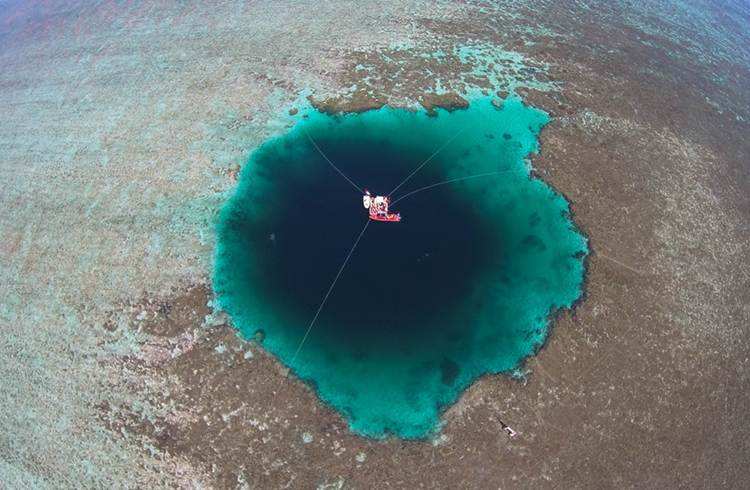Current Events Lesson Plan: September 29-October 5, 2016
Current Event: The Deep Deep Dragon Hole
Chinese scientists recently learned that a fabled ocean depth known as the Dragon Hole, a huge underwater chasm located in the South China Sea, is the deepest such natural feature in the world. For most of the past year, researchers made risky dives and used sonar scanners and underwater robots and cameras to explore the hole’s murky depths. They eventually found the Dragon Hole to be 987 feet (300 meters) deep. This makes it the deepest blue hole, a kind of vertical underwater cave, in the world’s oceans. A blue hole is a type of sinkhole, a bowl-shaped depression in Earth’s surface that forms where the ground sinks, collapses, or washes into underground openings. Blue holes get their name from their distinctive deep blue color, a sharp contrast to surrounding, shallower, aquamarine waters. Blue holes can be dangerous for divers to explore because below about 300 feet (100 meters), there is virtually no oxygen and little light. The steep walls of a blue hole extend into the dark depths, and it is often difficult to determine how far down the bottom lies.

Aerial view of the experts and staff exploring the Dragon Hole on July 24, 2016 in China. Also known as the Sansha Yongle Blue Hole, it is the world’s deepest such underwater feature. Credit: © Luo Yunfei, VCG/Getty Images
Objective:
China is a large country in eastern Asia. It is the world’s largest country in population with over 1 1/3 billion people—about 20 percent of all the people in the world. China is one of the largest countries in the world in area. Agriculture has always been the chief economic activity in China. Most of the people live in rural villages, and over half of all workers are farmers. However, China has some of the world’s largest cities. Shanghai is China’s largest city and one of the world’s largest as well. Beijing, the country’s capital, is the second largest city. About 100 Chinese cities each have more than a million people. China is one of the world’s oldest countries, with a rich history that stretches over thousands of years. The country’s written history goes back about 3,500 years. The Chinese were the first to develop the compass, paper, and porcelain. They undertook huge construction projects, such as the Great Wall. The Behind the Headlines news story and related World Book articles explore China and other countries.
Words to know:
Discussion Topics:
1. Ask your students what they know about Asia. (Students might say that Asia is the largest continent in both size and population; most of Russia, the world’s largest country, is in Asia; China and India, the world’s two most populous countries, are in Asia; the world’s highest (Mount Everest) and lowest (Dead Sea shore) places are in Asia; the world’s major religions began in Asia—Buddhism, Christianity, Confucianism, Hinduism, Islam, and Judaism.)
2. Including China, eight Asian countries have a population of at least 100 million. See how many of the other seven countries your students can name. (Students should say Bangladesh, India, Indonesia, Japan, Pakistan, Philippines, Russia.)
3. Ask your students to use World Book’s Timeline feature to view or add to the History of China timeline. (Students may wish to use World Book’s “China” article for help.)


